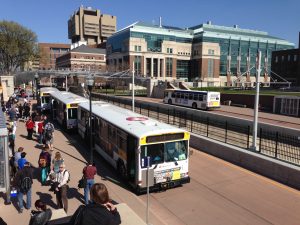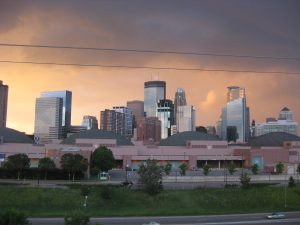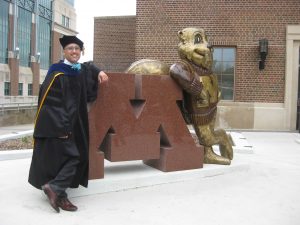
I moved to the Twin Cities from San Diego, California in the summer of 2008 to pursue a PhD in American Studies at the University of Minnesota. During my first two years in graduate school, I lived in Stevens Square, just south of downtown Minneapolis, in an old brick apartment building that faced I-94 and the Convention Center and that was around the corner from the now defunct African American Museum and Cultural Center. I remember driving around neighborhoods in South Minneapolis during recruitment weekend and falling in love with the urban charm of Stevens Square, which featured a park nestled among three-story brownstones. I chose to live there because of its affordability and its accessibility to several bus routes.
Some folx expressed concern for my safety in living in such a neighborhood. I immediately registered that concern as likely being connected to the neighborhood’s history of drug use and crime and indirectly to its higher concentration of visibly Black residents in comparison to other neighborhoods such as the Wedge or Whittier, where more U of M grad students lived. However, I felt comfortable walking and going for runs around the neighborhood. I kept to myself and others did the same. And while I became more alert after friends who happened to be White were mugged on their way home from the 19 Bar (Minneapolis’s oldest gay bar) in adjacent Loring Park (though I do not recall the physical description of the assailant(s)), my sense of safety did not necessarily change; I tend to be anxious in public settings and aware of my surroundings, perhaps because I had been policed by White authority figures in schools and malls during my adolescence for looking like an “Asian gangster” (which in the 1990s meant an Asian person wearing baggy clothes).

As a transplant from southern California, one of things I loved about living in the Twin Cities was its public transportation system. Riding the bus or the light rail meant I could save some money on gas, parking, and auto maintenance, not so trivial on a graduate student income; I also could use my commute time to catch up on endless reading for coursework and research. During the two years I lived in Stevens Square, I often took Metro Transit Local Bus Route 2 because it was a direct line to the U of M via Franklin Avenue. Sometimes, I would take the 17 or 18, which runs along Nicollet Avenue, and transfer in downtown to one of the lines that went to the U (which the light rail Green Line has replaced). I preferred the 2, since I did not have to transfer—a considerable detail, especially during the six months of Minnesota winter. However, despite the twenty or so minutes it would take from my stop at Franklin and 3rd Avenue to the U, the ride felt long, as we traversed Franklin before turning at 26th Avenue and riding up Riverside Avenue.
Through my daily commutes, I began to learn the racial and class geographies of Minneapolis. Between Nicollet and the light rail Blue Line, I noticed more Black, Indigenous, and Latinx passengers than there were from the Blue Line to the U. As a queer Filipinx first-generation graduate student, I appreciated riding with other people of color and not standing out for being non-White; but I also felt ambivalent because of our perceived class differences: whereas I was riding the bus en route to a doctoral degree and the social, cultural, and economic capital it provides, other passengers of color were riding the bus for other purposes that presumably diverged from my upwardly mobile trajectory. Arriving at the U reminded me that I was entering a predominantly White space, a space not designed for people like me or most of the passengers on my daily commute. Nevertheless, riding the 2 allowed me to recognize some of the city’s unique diversity—from the halal market on the corner of Portland Avenue, to Maria’s Café in the Ancient Traders Market, to the Minneapolis American Indian Center at Bloomington Avenue.During my last two years of grad school, I lived in Whittier, which gave me walking access to southeast Asian and Mexican restaurants along Nicollet’s Eat Street as well as Limited Stop Bus Routes 113, 114, and 115, which I boarded and exited along Lyndale Avenue. Like many grad students, I appreciated these express routes, which provided direct service to the U and cut my commute time by half or more than local bus service routes. However, unlike my commutes along Franklin, I no longer had the opportunity to observe the city’s more diverse streetscapes as we bypassed them on I-94. Also, most of the passengers were headed to the U, a Whiter space than the Minneapolis neighborhoods I lived in.
As I reflect on my time in the Twin Cities, a little over a month after the murder of George Floyd and the uprisings that ensued in areas I used to walk, run, bike, and drive past, I am reminded that multiple worlds exist at the same time and in the same place. These worlds are racialized, as well as sexualized, gendered, classed, and abled. Riding various bus routes and the light rail, I experienced fleeting intimacies that prompted me to question my queer diasporic Filipinx embodied relation to others unlike me. As an Asian American pursuing an advanced degree, I fit somewhere in between the Twin Cities’ racial matrix. This sense of being “not quite” is a familiar feeling I have wrestled with as a queer man living in a heteronormative society, the son of Filipinx immigrants whose homeland, the Philippines, bears the scars of Spanish, American, and Japanese colonialisms, and as an Asian American person whose experience of race often is erased in the Black-White racial paradigms that tend to dominate discussions of race in the United States.
The Twin Cities is where I solidified my political consciousness. My formal education at the U affirmed my belief in the power of knowledge to transform society; however, I also learned that I would have to put in the work to center marginalized voices, including my own. While my graduate program approached the “American” in its namesake from decolonial, critical race, and transnational perspectives, my seminar classmates from and beyond the program did not always reflect such embodied ways of knowing. As an Asian Americanist, and Filipinx Americanist more specifically, I often engaged with texts that seemed of little value to my peers, in addition to the texts I felt compelled to know in order to converse with them. Sometimes being the only Asian man was palpable in these classroom spaces. And unlike the University of California, San Diego, where I completed my undergraduate degrees in Critical Gender Studies and Mechanical Engineering, the U was (and remains) a predominantly White institution. On one hand, I appreciated seeing more Black grad peers in comparison to my undergrad experience (Black students represented 3% of the grad population during my last year of grad school, 2013–14, while they represented 1% of the undergrad population during my last year at UC San Diego, 2004–05). On the other hand, I became part of a numerical racial minority at the U (whereas Asian students represented 41% of the undergrad population during my last year at UC San Diego, they represented 5% of the grad population during my last year at the U). Even though I knew I had every right to occupy university spaces, as one of the 12% of grad students of color, I often questioned if I belonged in academe. This is the psychic life of race. No one directed overt racism toward me; rather, the structures of higher education created the conditions for someone like me to be grateful to simply inhabit the fringe. And as someone who researches on the communities in which they are a part, the charge of “me-search” devalued my work; sadly, to this day, someone in the academy who has the power to advance my scholarship will say that my work is “illegible,” which I have come to understand as “not part of the norm.” However, the invaluable mentorship I received from queer and trans* faculty and faculty of color reveals there is more than one narrative of the U and the Twin Cities; (I place an asterisk after trans to signal the variety of gender identities and expressions that exceed cisgender ones, though this notation is not without controversy).Living in Minneapolis gave me a new perspective on race in the United States and inspired my dissertation on queer literary and cultural representations of Filipinxs in the Midwest, which I am transforming into my first book manuscript. This project argues Filipinxs and other people of color appear as out of place in the Midwest because the region figures as the nation’s heartland, and that narrative is premised on White supremacy and settler colonialism. If I never stepped outside my California comfort zone and braved the unknown middle, I would not be the scholar I am today, nor would I know how to navigate predominantly White spaces and still find ways to queer and Filipinize them.

In transit, from South Minneapolis to the U, I witnessed the uneven racial dynamics of the Twin Cities. Attending grad school in Minnesota also was a period of transition into adulthood. And as I write with some critical and physical distance from that formative moment in my life, amid local, regional, national, and global racial reckonings and an ongoing pandemic that has generated a resurgence of anti-Asian sentiment and action, I recognize that we, as a society, are in transition—that our current world is not enough, that it has never been enough for some, but that it also does not have to be this way. I am hopeful for a world where and when Black lives will truly matter, and the intersectional coalitions already underway give us glimpses of that world yet to come.
Manhattan, KS
July 5, 2020
Previous Reflection Next Reflection
Return to the Wonderful/Wretched Series introduction.
